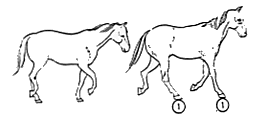The Trotting Breeds
Where Soundness & Candence are Paramout
Sign our Letter
Stop the Overreach of HPA 2025
Equine Sports Council (ESC) exclusively sanctions events for the Show Horse and Sport Horse TROTTING BREEDS. The Show Horse Trotting Breeds include the American Saddlebred, Arabian, Dutch Harness Horse, Friesian, Hackney, Morgan and Standardbred Road Horse. The Sport Horse disciplines include Hunters, Jumpers, Combined Driving and Dressage. The trot is a two beat diagonal gate naturally apparent in 70% of horse breeds.
This educational video identifies the show horse trotting breeds and explains the mechanics of the trot.
The trot is faster-paced and more animated than the walk. When Trotting Breeds are shown under saddle, the English riders are required to “post the trot” – or rise and fall in the saddle in time with the horse’s stride to avoid bouncing in the saddle. This creates a more comfortable ride for both horse and rider. Cadence and soundness of the horse is considered the utmost of importance in judging Trotting Breeds. Horses that are lame cannot soundly execute a two-beat diagonal trot, as their weight is evenly distributed.
Of the Trotting Breeds, the American Saddlebred is one of the only horses that has the hereditary ability to learn two additional gaits, the Slow Gait and Rack. These “ambling” gaits, typically performed by breeds that are Naturally Gaited, are smooth gaits where only one foot is on the ground at a time.
In order to demonstrate the variation in these gaits, an American Saddlebred exhibiting at the Trot is shown below on the left. Note that the horse has its weight evenly balanced in this diagonal gait with one back foot and the opposite front foot on the ground at the same time. Any lameness or soreness would prevent a square cadence at the trot.
The same horse is pictured below on the right demonstrating the Rack. This is a fast-paced lateral gait where only one foot strikes the ground at a time. Lameness or soring of an American Saddlebred would be detrimental to the ability to perform a balanced, square trot. All American Saddlebreds, in every class, in every division, are judged at the trot. It is counterproductive to sore any Trotting Breed horse, as they would be unable to perform well at the trot.


North American Show Horse Trotting Breeds are bred for their natural ability of trotting with collection. The trotting breeds, even as foals at play in a pasture, naturally trot with high animation and head collection.



Horse Locomotion
Introduction
by Montana State University
Full Article
A basic understanding of how horses move can be very useful in riding, training, analyzing and caring for your horse.
A gait can be defined as a particular way of going, either natural or acquired, which is characterized by a distinctive rhythmic movement of the feet and legs. The natural gaits which we would see in the wild state are walk, trot, pace and gallop. Under domestication some have been modified and are called acquired gaits. These are the slow lope, running walk, rack, stepping pace, and fox trot.
We can also classify gaits according to how they ride. For instance hard gaited and easy gaited. Both of these are affected by conformation, breed and training. For example, steep shouldered horses are usually hard gaited while long sloping shouldered horses are usually easy gaited.
The breed effect may be seen; for example, between walking horse breeds and other breeds. Young horses are usually rough gaited until they learn to carry the rider’s weight.
The essentials of a satisfactory way of going is straight-line action, long strides, regularity of gait (meaning free, fluid and regular), and briskness of gait.
Each of the gaits have a particular foot placement called beats. The first beat of a gait is always started with the hind legs.
Walk
Characteristics
- Speed averages from 3 ½ — 5 m.p.h.
- Is a natural gait for all breeds.
- Sequence of steps is unchanged in the ordinary, collected, or extended walk
Marker 1 — The walk is a 4-beat gait; meaning each foot leaves and strikes the ground at different times.
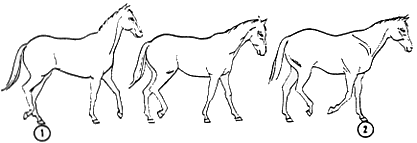
Marker 2 — Foot sequence – ex. left hind, left front, right hind, right front.
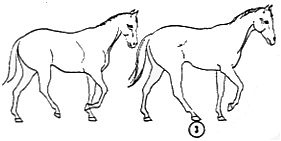
Marker 3 — Two of three feet are always on the ground at the same time; triangular base of support.
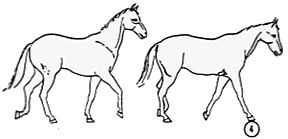
Marker 4 — No period of suspension when all legs are off the ground.
Trot
Characteristics
One diagonal pair of legs are raised before other pair touches ground — suspension of all feet. Period of suspension — longest at the extended trot. Leg sequence unchanged at ordinary, collected, or extended trot. Average speed 7-10 mph Extended 10-30 mph. Believed to be a dominant genetic trait over pacing. Is a natural gait.
Foot sequence
- left front/right hind (left diagonal) — 1st beat
- right front/left hind (right diagonal) — 2nd beat
Marker 1 — A 2-beat, diagonal gait
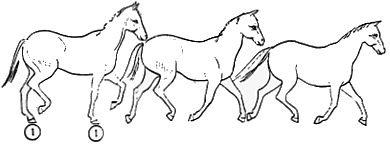
Marker 2 = Diagonal base of support
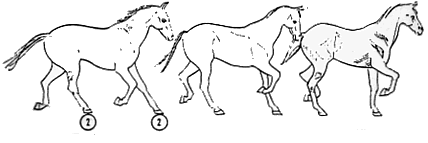
Extremes
- Standardbred — has rapid, long round-covering extended trot; used for harness racing; have a much longer period of suspension.
- Hackney — shorter stride; collected, animated trot; higher action and greater flexion of joints with no period of suspension.
Canter
Characteristics
- Defined as a collected or restrained gallop.
- A 3-beat gait.
- Base of support changes from one to two diagonal to one leg supporting weight.
- Period of suspension — is the best time for the rider to ask horse for a lead change.
- Average speed 6-10 mph.
- Natural gait to all breeds.
- Sequence of steps changes depending on lead and direction of travel
Leg sequence — right or left lead, depending which foreleg is leading; in a circular path, the inside foreleg and inside hind leg travel in a more advanced position. (See figure below).
Right lead: Left hind — 1st beat Right hind/left front — 2nd beat Right front — 3rd beat Period of suspension — after right front leaves ground
Left lead: Right hind — 1st beat Left hind/right front — 2nd beat
Left front — 3rd beat Period of suspension — after left front leaves ground
Disunited Canter (Cross-firing)
When the horse, for example, changes from left lead to right lead in the front, but does not change the hind legs, or vice versa. The sequence for this example would be: RH, LH and LF, RF
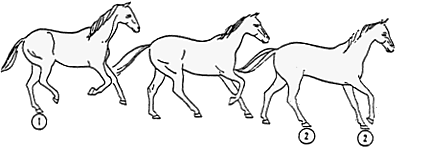

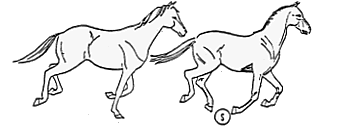

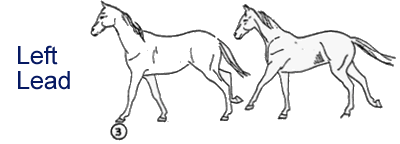
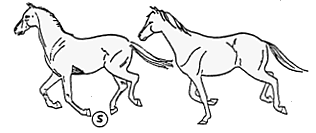
Gallop
Characteristics
- 4-beat gait.
- Fastest gait of horse (12-20 mph).
- Similar to canter (lope), but the paired diagonals do not land at the same time – extended to two beats: hind foot hits before the diagonal front foot.
- Has right or left lead depending on direction of travel.
- Period of suspension is after last front foot leaves ground.
Sequence of steps will change depending on lead — race horses will change leads during race to shift weight and decrease fatigue on leading foreleg.
Natural gait to all breeds.
- Thoroughbred has been bred for his speed at this gait.
- Faster race horses found to spend a shorter period of time in the stance phase of this gait; less time with feet on the ground (See figures below).



Pace
Characteristics
- A rapid 2-beat lateral gait.
- Horse tends to throw body from side to side (termed a body pacer)
- Generally used in harness racing, not for riding — the swinging action of horse’s body makes it uncomfortable to ride.
- Is faster than the trot; average speed 6 up to 30 mph.
- Is homozygous recessive genetic trait.
- Not a natural gait to all breeds.
Breed’s pace is natural to:
- Standardbred — bred to race under harness.
- Icelandic – small horse 13.2 – 14 hands, weighing up to 1000 pounds; has 5 natural gaits: walk, trot, canter, pace and tolt (running walk). Pace used for short distances at high speed; known to reach up to 40 mph (See picture following page)
Sequence of steps is unchanged.
Leg sequence
- left hind/left front — 1st beat
- right hind/right front — 2nd beat

